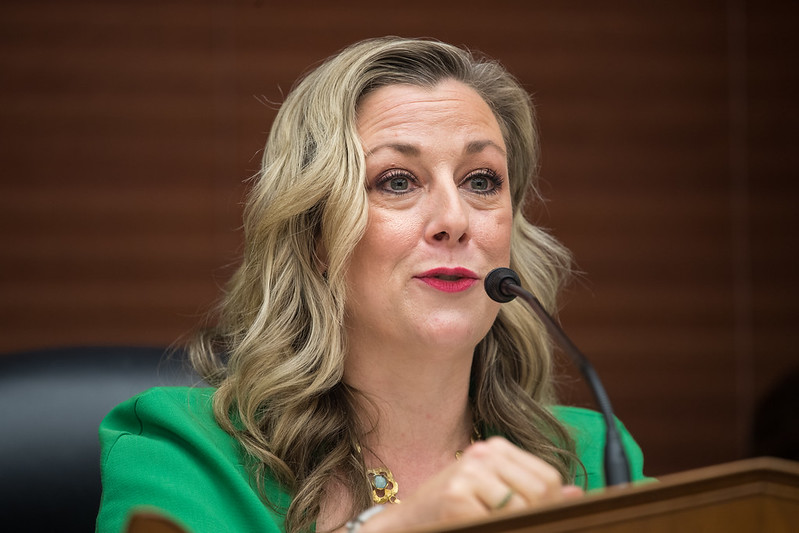NASA authorization bill advances in House. Proposed limits on commercial partners spur concern

NASA's authorization bill will proceed further through the House of Representatives without, so far, any amendments addressing major concerns raised by the agency's administrator about its effect on lunar exploration.
The House Subcommittee on Space and Aeronautics approved the bill's passage — with minor amendments — to the full committee on Wednesday (Jan. 29). Subcommittee members agreed to postpone some of the amendment discussions about the moon until the bill moves further along the process.
NASA Administrator Jim Bridenstine has said the bill, dubbed HR 5666, "imposes some significant constraints on our approach to lunar exploration." Bridenstine's statement, posted to NASA's website on Monday (Jan. 27), said he was concerned by the 102-page bill's directive that the human lander system for the Artemis moon program be "fully government-owned and directed." He called this approach "ineffective" since it would limit participation by commercial partners.
Related: NASA's Artemis Moon Program Just Photobombed a Spacewalk (Photo)
"The approach established by the bill would inhibit our ability to develop a flexible architecture that takes advantage of the full array of national capabilities — government and private sector — to accomplish national goals," Bridenstine wrote.
At stake are the details of NASA's approach to send humans back to the moon. President Donald Trump's administration tasked NASA last March to land humans on the moon's south pole in 2024, four years earlier than the agency had previously planned. HR 5666 would push that deadline back to 2028, but allow NASA to proceed sooner if a mission were deemed fiscally feasible and safe.
The Trump administration's 2024 mandate requires NASA to safely and swiftly undertake large programs such as designing and testing new lunar spacesuits and certifying a massive new rocket (the Space Launch System) to carry humans, all in less than five years. And so NASA is heavily emphasizing commercial partners on this lunar venture, both to build large systems like the lander and to provide a cargo supply chain.
Breaking space news, the latest updates on rocket launches, skywatching events and more!
Bridenstine's concern is that the new House language could interfere with that arrangement. Two members of the subcommittee from Florida, where NASA's Kennedy Space Center is located, echoed Bridenstine's concerns. But both agreed to discuss amendments later in the bill approval process.
"The bill, as written, would limit commercial competition and participation in the moon and Mars program," Charles Crist, D-Fla., said during the subcommittee meeting, adding it could cause "a lot of heartburn for a lot of people." Michael Waltz, R-Fla., said he shared Bridenstine's worries and criticized the budgetary process for leaving just a few days between the bill's introduction late last week and the markup meeting.
"There was not enough time … to receive adequate feedback from the committee," Waltz told subcommittee members, saying that a bit more breathing room "would have led to better agreement on some difficult issues."
Multiple subcommittee members reassured NASA that it could keep to the 2024 timeline for landing on the moon, as long as it was financially feasible and safe to do so. "This bill is not about rejecting the Artemis program and delaying humans on the moon until 2028; NASA can work to get there sooner," subcommittee chair Kendra Horn, D-Okla., said in her opening remarks.
Horn also emphasized the importance of positioning NASA's moon push in the context of a human Mars-orbiting mission, which HR 5666 asks for in 2033. The Red Planet deadline is in line with previous statements from Bridenstine, who has hinted at such a mission in the mid-2030s.
Amendments to HR 5666 approved on Wednesday concerned matters such as commercial use of NASA facilities and access routes to launch facilities at Kennedy Space Center. HR 5666, however, proposes several significant changes to NASA's programming, most of which were discussed only briefly at the meeting. These include directives such as extending the International Space Station's lifetime beyond 2024 to 2028 and creating a moon-to-Mars program office to oversee human exploration at those worlds.
The bill suggests moving the proposed Gateway space station from lunar orbit to the vicinity of the moon to allow the structure to support Mars exploration as well. HR 5666 also discusses various science missions (including support for the high-profile Europa Clipper), aeronautics technologies and the need to keep an eye on Chinese space exploration.
While HR 5666 proceeds to discussion among the full committee, it will eventually need to be reconciled with the Senate's separate version for NASA. The Senate Committee on Commerce, Science and Transportation approved a bill in November that included an ISS extension to 2030 and a human Mars mission after the lunar return.
- Could NASA Build the Famous Saturn V Today? It's Working on It, with a Twist
- The World's Tallest Rockets: How They Stack Up
- Photos: NASA's Space Launch System for Deep Space Flights
Follow Elizabeth Howell on Twitter @howellspace. Follow us on Twitter @Spacedotcom and on Facebook.

Elizabeth Howell (she/her), Ph.D., was a staff writer in the spaceflight channel between 2022 and 2024 specializing in Canadian space news. She was contributing writer for Space.com for 10 years from 2012 to 2024. Elizabeth's reporting includes multiple exclusives with the White House, leading world coverage about a lost-and-found space tomato on the International Space Station, witnessing five human spaceflight launches on two continents, flying parabolic, working inside a spacesuit, and participating in a simulated Mars mission. Her latest book, "Why Am I Taller?" (ECW Press, 2022) is co-written with astronaut Dave Williams.
